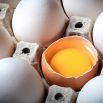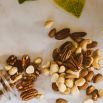We often hear experts say that when it comes to shedding some pounds, "moderation is always the key." Automatically, we associate it with the words control, small servings and portion. But, how much is too much and how little is moderate?
According to Dr. Lisa Young, an internationally recognized nutritionist and author of "The Portion Teller Plan", she has spent almost 20 years trying to tell people that "losing weight is the easy part. Keeping the lost weight off and developing long-term healthy habits you can stick with is a far greater challenge."
Dr. Young believes that portion-control is the simplest and most effective way for people who are trying to lose weight reach their goal. "Ultimately, regardless of which method you try, in order to succeed at weight loss, you have to eat fewer calories."
Because many diet trends tell people to eat as little as possible, people think of portion control as self deprivation and fasting. Fads more often than not dictates its followers what to eat and what not to eat. The difference between those and practicing portion control, "you get to eat the foods you love (just not huge amounts every day) without cutting out certain food groups entirely".
As an advocate for proper health knowledge and portion control practice, Dr. Young has rounded up some of the tricks that might just help you lose those unwanted pounds in the best way possible. "Many of these tricks are rooted in behavior change which serve as cues to gently remind us to eat mindfully...to eat when hungry...to eat more slowly...and to eat less," Young shared.
1.Go retro.
Several decades ago, people eat in small portions. Eating in smaller servings are originally hardwired in the system of humanity. According to Dr. Young, people in the 1950s were smaller because they eat with control. "I've spent a good part of my career tracking how our food portions have grown -- and how our waistlines have too. Rates of obesity increased as portions rose," she expounded.
See: The CDC Graph illustrating the direct relationship of food portion to body size.
2. Eat a small breakfast.
Forget about that saying that you should eat like a king during breakfast. But still, everyone should grab a bite as soon as they wake up.
"I recommend that dieters eat within two hours of getting up. It doesn't have to be a huge feast though. In fact, a smaller breakfast may actually be best."
A study also shows that people who ate a small breakfast ended up eating less throughout the day, compared to people who started their day with a feast. Dr. Young says: "Often, we think if we eat a big breakfast, we'll eat less for lunch or dinner. Unfortunately, it doesn't always work out that way."
Eating brunch is also alright, but be sure to include fiber and protein to the first meal of your day for these nutrients keeps you feeling full.
3. Cut your pizza pie into smaller pieces.
"We tend to eat in units. Most of us don't share a slice of pizza, a bagel, or a soda (or other foods which come in units) with a friend," explains Dr. Young. Our brain is programmed to think that one unit is equivalent to one serving, which is actually not the case. The next time you drink a bottled beverage, inspect the nutrition sheet and see that one bottle is actually a good two-three servings.
One study suggests a simple way to trick our brain, cut your food into fewer, smaller pieces. The researchers used a whole pizza cut in 16 pieces, instead of the usual eight. The results showed that the same number of people ate less.
4. Beware the health halos.
Don't be fooled by labels "low-fat," "gluten free," and "organic." A lot of us think that foods with this note are actually a healthier alternative, but in fact, it is not.
Follow Dr. Young's suggestion: "Keep an eye on your portion size even if you think a food may be good for you. Low-fat cookies are still cookies and gluten-free crackers are still crackers. And both products do indeed contain calories which add up pretty quickly."
5. At times, you can eat more to weigh less.
Sometimes, we gain weight because of the volume of the food we consume but by the nutrition these foods contain. If you are a volume eater, "fill up on fruits and veggies which tend to be low in calories (while also being nutritious)." This will surely make you feel full and signal your brain that you are actually eating a lot.
6. Souper-size it!
You can never go wrong with eating soup for appetizer. You will be feeling fuller more immediately because soup is 80% water. It follows the same idea of drinking a few glasses of water before each meal so you wont overeat, but in a more delicious and tasty way. Vegetable-based soups are the best option.
7. Take out the measuring cups once in a while.
"While it is not exactly practical to measure your food when you are eating out, and I don't suggest you weigh your food daily, finding out just how big -- or small -- your portion is can be quite an eye opener," Dr. Young explained. We should also be aware of the nutritional contents of the food we are eating, and not only focus on the amount we consume.
8. Take a look at your hand.
The body is our greatest tool. "While you don't always have measuring cups with you, you always have your hand. Which is why I created the "handy guide" to estimating your portion size", Dr. Young said. According to her book, a 3-ounce portion of meat or chicken more or less looks like the palm of your hand and a fist looks like 1 cup pasta or rice.
9. Downsize your food packages.
Buy products that offer single servings so that you wont be tempted to eat up the whole thing on one sitting. Another tip is put each serving in separate bags which comes handy as snacks when you get hungry.
10. Slow down.
A few studies have proven the direct relation of eating slowly with weight loss. "When we eat more slowly, we tend to eat more mindfully, and, in turn, eat less", Dr. Young discussed. "One way to slow down is to count your bites," she suggested.
See: Using Forks Actually Make You Lose More Weight
Though counting while chewing is not really enjoyable, we should pay attention to how many bites or spoonful we already consumed. "Try it once in a while."
11. Eat off of grandma's dishes.
"Food portions are not the only things that grew over the years -- our plate sizes have too. And research has found that we eat more if plates or glasses are large," Dr. Young shared.
Remember that trivia we discussed earlier? That people generally ate in smaller proportions back in 1950? One tip to trick the mind of the satisfaction we ate a lot is to use grandma's dishes.
"A client of mine did this and lost 20 pounds, effortlessly. If we downsize our plate, we tend to eat less. A small portion looks bigger on a smaller plate," she justified.
12. Commit to cooking more in 2016.
A study recently found that cooking was associated with a slightly lower risk of developing type 2 diabetes. People who ate more home cooked meals gained little weight and has lower risk of obesity. This can be linked to the amount of chemicals and preservatives used in making processed and fast food.
"These findings don't surprise me. Restaurant portions tend to be larger than amounts we would typically prepare at home. Foods eaten out also tend to be more caloric than home cooked meals."









